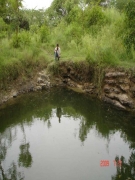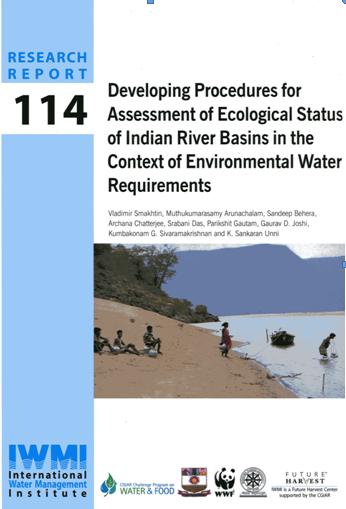/sub-categories/information-education-and-communication-campaigns
Information, Education and Communication Campaigns
Points of groundwater discharge: Types of springs – A presentation by ACWADAM
Posted on 26 Aug, 2010 08:52 PMThis presentation by ACWADAM deals with springs, their characteristics and types. Springs are indicated by locations or points on the ground surface, where water from beneath the ground emerges on to the surface. A common example is of an overflowing unconfined aquifer.
Some of the characteristics of springs are:
- Discharge from spring may be constant or variable.
- Springs can be perennial or seasonal.
- Discharge from a spring may vary between from a trickle to about 100 cum per second.
- Difficulty in access.
- Variation in discharge.
- Temperature of spring water may vary from mean atmospheric temperature to lower or higher, even boiling temperatures. Hot quality water springs are common to many parts of the world.

Environmental flows in river basins: A case study of river Bhadra - Current Science
Posted on 26 Aug, 2010 12:50 PMThe quantity and seasonality of water flow in a river may greatly change from its normal condition between a major storage and downstream, thus paving the way for drastic changes in the riverine ecosystem. ‘Environmental flow’ refers to the amount of water considered sufficient for protecting the structure and function of an ecosystem and its dependent species.
The paper goes on to describe the case of river Bhadra, which is the site of a dam that has significantly altered the natural flow of the river and describes the study that aimed at conducting the environment flow analysis of the river.
Groundwater externalities of surface irrigation transfers under national river linking project: Polavaram – Vijayawada link
Posted on 25 Aug, 2010 05:00 PMThis document published by IWMI and CGIAR describes the details of the Polavaram project, which has been planned by the state of Andhra Pradesh as a multi-purpose project:
- to provide irrigation benefits to the upland areas
- to provide a water supply to the industries in Visakhapatnam city, including the Steel Plant, for the generation of hydropower
- for the development of navigation and recreation facilities.
The project envisages the construction of an earth-cum-rock filled dam that is 1,600 m long across the Godavari River at Polavaram, and about 42 km upstream of the Godavari Barrage at Dowlaiswaram.
Water for All - An educational booklet by Utthan
Posted on 25 Aug, 2010 10:32 AMThis document is an educational booklet on water management, published by Utthan, which works towards empowering women's groups to seek clean and adequate quality of water for all.
The booklet provides background information on water as an important natural resource and the importance of protecting and maintaining the quality and quantity of this natural resource.
The details have been explained in a manner that is simple and understandable and include illustrations that are self explanatory and easy to follow.
The booklet is divided into the following sections:
Seven Steps to Hygiene - An educational booklet by Utthan
Posted on 25 Aug, 2010 09:22 AMThis document is an educational booklet on sanitation and hygiene published by Utthan, which works towards empowering women's groups to seek clean and adequate quality of water for all.
The booklet includes the details of seven steps that can be undertaken to attain sanitation and hygiene. The details have been explained in a manner that is simple and understandable and includes illustrations that are self explanatory and easy to follow.
The seven steps include:
- Use and protection of water sources
- Managing drinking water
Pani Panchayat: A model of groundwater management – A presentation by ACWADAM
Posted on 25 Aug, 2010 08:20 AM The presentation by ACWADAM deals with Pani Panchayats as a model of groundwater management.
The presentation by ACWADAM deals with Pani Panchayats as a model of groundwater management.
Pani Panchayat is the name first given to a movement by Mr. Vilasrao Salunke for motivating farmers of Naigaon village of the drought-prone Purandhar taluka of Maharashtra in 1974. The government's inability to deal with the drought situation prompted him to take a 40 acre land on lease from the village temple trust and develop a recharge pond in the recharge area of the village, a dug well in the discharge zone and a lift irrigation system.
Farmers got impressed with the results demanding a scale up of the experiment leading to the setting up of Gram Gaurav Pratisthan (GGP) through which the work was expanded to encompass both groundwater and surface water management.
Measurement of weather parameters: Data collection and analysis – A presentation by ACWADAM
Posted on 24 Aug, 2010 09:29 PMThe presentation by ACWADAM deals with measurement of weather parameters and outlines the methods used in weather related data collection and analysis. Weather information is necessary for the planning and implementation of watershed programmes, especially in understanding factors like groundwater recharge, the relationship between recharge & discharge and in aspects like irrigation planning.
Augmenting groundwater resources by artificial recharge: A case study of Kolwan valley by ACWADAM
Posted on 24 Aug, 2010 04:19 PMThe presentation by ACWADAM deals with a case study of augmenting groundwater resources by artificial recharge in Kolwan valley, Mulshi taluka, Pune. The DfID funded project was undertaken by the British Geological Survey in collaboration with its partners in India from 2002–2005. The objectives of the study were:
- Improved knowledge of the impacts of managed aquifer recharge in different physical and socio-economic settings.
- Guidance on scope and effectiveness of managed aquifer recharge for implementers, funders and policy makers.
- Dissemination of knowledge.
Environmental flows A methodology of calculation for India (Part 1)
Posted on 24 Aug, 2010 10:07 AM
In order to maintain the ecological goods and services of rivers and other hydrological regimes like wetlands, lakes, etc., environmental flow allocations (eflows) are a necessity. At the same time, water demands in India are increasing and will keep increasing and solutions like waste water treatment, pollution control, correction of leakages and wastage of water, efficient irrigation systems, efficient agricultural systems, etc., will take considerable time to evolve, even with our best efforts. So what should we do in the meantime? There are vulnerable ecological systems on the verge of collapse..How do we respond to these challenges?
Pumping tests on wells: A means of measuring the storage and transmission properties of aquifers
Posted on 24 Aug, 2010 10:03 AMThe presentation by ACWADAM is part of the training module developed by them on “Planning, development and management of groundwater with special reference to watershed management programmes”. Pumping a well and observing the effect of such pumping on the water level in the pumped well as well as in the adjoining parts of the aquifer through observation wells is the basic procedure involved in a pumping test.
